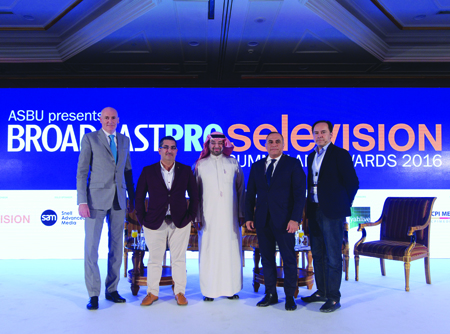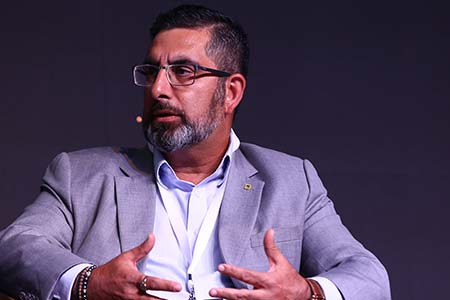MENA's TV heads discussed the state of TV entertainment in thernregion and the dynamics of free-to-air and pay-TV. The head honchos also shared insights about their strategies and business models.
 MENA’s TV heads discussed the state of TV entertainment in the
MENA’s TV heads discussed the state of TV entertainment in the
region and the dynamics of free-to-air and pay-TV. The head honchos also shared insights about their strategies and business models
The final panel discussion of the day was the CEO panel with Sam Barnett, CEO of MBC Group; Sanjay Raina, GM of Fox International Channels, Middle East; Emad Morcos, Chief Content Officer at OSN; and Dr Raed Khusheim, CEO of Selevision.
Moderated by Karim Sarkis, the panel touched on a number of talking points, such as the shift of linear TV from free-to-air to pay, big broadcasters content strategy and the role of new digital platforms. Sarkis began by asking the panellists about their outlook for 2017.
Emad Morcos of OSN said that 2017 will represent the next step after the Orbit-Showtime merger in 2009 and the creation of OSN. This is the next milestone in business for OSN and the focus in the coming years will be the networks OTT proposition and 4K products, he said.
We are excited about the initiatives that we will be rolling out in the coming months; needless to say, the outlook is very positive, he commented.
Sarkis then asked Sanjay Raina of Fox International Channels about Fox’s recent move from free-to-air to pay and how it is benefiting the company.
According to Raina, the shift was a necessity because the network did not see much value in the free-to-air portfolio. He added that there is unsated demand for content across platforms, delivery modes and geographies.
The consumer wants good content; whether it comes from free-to-air or pay TV, it doesnt matter to the end user. We will keep generating great content and introducing more brands, as we believe this region has immense untapped monetising opportunities, he said.
Regarding Selevisions strategy in 2017, Dr Raed said the company will continue to collaborate with content providers to create value-added products for the MENA consumer.
Sam Barnetts view was quite positive too. He responded to negative forecasts by saying that while the industry has suffered because of the dipping oil price, there are several reasons to be upbeat about the future.
Even in mature markets, people are taking a positive view on the future. In emerging markets like the Middle East, that should be even more positive.
We have been very aggressive on TV. I think one of the things thats going to happen is that with the satellite configuration changing in the MENA to 26 degrees East and at 7 degrees, we expect to see a new advertising market bubble up. Now we have popular channels in the Gulf, we have our own channels in Egypt and the spot beam in North Africa; we are geared up to exploit that growth, he said.
Sarkis asked the panellists if the shift to pay TV is the way forward and whether Foxs move to pay is only the tip of the iceberg, with many more channels following suit. Will spot beams revitalise the FTA market?
Raina repeated that in his view, the industry is not segregated in terms of pay or FTA. These are just means of delivering content to the end user, he pointed out.
Indonesia and Taiwan are examples of how ad revenues can result in thriving robust markets. We look at generating value irrespective of the means of delivery, be it free-to-air or pay. We had our reasons to move to the pay environment. Having said that, if the market changes and there are better opportunities in FTA, we can go back to the old model.
Raina pointed out that Fox still has one FTA channel, Nat Geo Abu Dhabi, which runs on advertising and not through a licensing fee. The decision was to move entertainment away from FTA.
Morcos, however, had a different view of the two business models.
The consumer clearly knows the difference between free-to-air and pay TV, especially when it comes to premium content and specialty channels. As a pay TV operator, our services entail much more than delivering linear channels. We also offer value-added services such as catch-up, on demand and TV everywhere to give the viewer a 360-degree experience, he said.
Barnett interjected to say that as a free-to-air operator, even MBC offers over-the-top value-added services such as catch-up, in addition to premium content from the best studios.
With 1,200 FTA channels in a region with more than 75 million TV households, only 5 million pay for TV, he said.
Morcos listed the additional services pay TV offers.
We have several offerings to differentiate our content, our pay-per-view proposition being one. We offer bundled services as box sets to give the viewer choice of the way they want to watch content. The value of premium content lies in its release window; by the time content reaches the free-to-air window, it is already quite old, he noted.
Dr Raed further supported Morcos, saying that the long window leads to piracy as well.
Regardless of the competition, piracy is a common enemy. Even FTA suffers because of piracy. Pay TV operators have their own set-top boxes, its just inconvenient to the user to have several set-top boxes.
Raina disagreed with Dr Raed, saying piracy cant be blamed for a stagnant market.
Piracy is a worldwide phenomenon, and despite that the markets are growing. Take the example of India, with 140 million DTH households. Piracy of Indian DTH boxes is unabated, yet the business is growing. Malaysia has widespread piracy too, but the business there is growing. We need to be more innovative in our offerings to woo the consumer. Where are the skinny packages? Do we understand our customer? OTT has immense potential, are we doing enough to harness that?
Sarkis asked Morcos if OSN had plans to rethink its business model in terms of redesigning its packages to address lower price points given the increased competition from beIN.
A year ago, we introduced packages to address different markets in the region with different GDPs. As our business evolves, we are speaking to partners to create skinny bundles and work out lower prices. While content is important, how we package and sell it is the key, Morcos said.
Sarkis asked Barnett about MBCs strategy going forward with its set-top boxes. He said that advertising in a market with 250 million potential users is a huge opportunity for growth.
MBC has had a pay channel since 2008. For the HD channels, the studios demanded that we encrypt the channels. We have Shahid, which is a free OTT product and Shahid Plus, which follows a subscription model. Sports is a challenge to monetise on FTA and so we just encrypted the HD version of Saudi League on gobox, noted Barnett.
Sarkis asked the panellists about the outlook for beIN and Gobox?
According to Morcos, the introduction of more pay platforms in the market is a good sign, as it helps a behavioural change of consumers towards pay TV in general, making them more accepting of the phenomenon. Raina agreed that more providers will lead to a robust and healthy pay TV industry.
We derive most of our revenue from pay. I feel the region holds immense potential for the 5m subscriber pay industry to treble
or quadruple in the coming years, he said.
Sarkis at this point asked if the bidding wars are expected to become more common due to the increased competition in pay-TV, and whether this was having any impact on FTA rights market share.
The panel was then asked about the set-top box strategy and whether unifying them is a realistic proposition. Dr Raed said that future set-top boxes need to be HEVC-compliant, and that standardisation is a must for the industry to thrive.
The objective is to attract more eyeballs. There is room for better quality channels, as only 20% of the MENA channels are digital.
Barnett said that the control of the set top box is a defence mechanism for platform owners, as dominant operators could become gatekeepers with the power to block access to a market. He further added that the industry needs to be regulated to protect operators, which is not likely to happen as it involves political and infrastructural changes.
In the last segment of the discussion, Sarkis asked the panel about digital advertising.
It is said that the total spend on digital advertising by 2020 will be 50% of the total share. How quickly do you see this shift in allocation of resources? It is also said that 70% of this spend goes to Google and Facebook. How will this impact the industry?
Barnett maintained his stand: regardless of the new trends, there is enough room for TV advertising to grow in emerging markets. He added that digital revenues are growing very fast but that has not led to a shift in or decline of revenues on mainstream TV channels.
On OSNs digital strategy, Morcos said user behaviour is changing, with more traction towards OTT products now than ever before. Sarkis asked if operators feel an urgency to accelerate premium products on OTT platforms.
Raina felt they do, saying that OTT is a reality, and channels and content owners need to focus on that with tailor-made products.
As far as the changes in the coming year, Dr Raed pointed out that linear TV advertising and digital advertising should leverage the digital advantage. He also emphasised that live TV advertising will be bigger.
The general consensus was that, regardless of the strategies, digital will be more important for both content owners and channels in 2017, and that companies will focus on further developing digital products.











































































